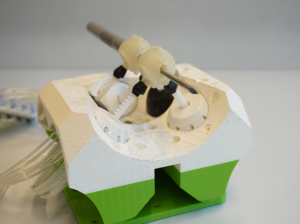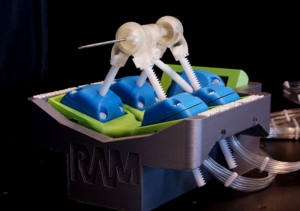 I first truly became aware of 3D technology sometime in 2010 or 2011, when I went to the mall with my co-worker during our lunch break to grab a chili dog and check out a large surgical robot that was being demonstrated in the center of the mall, where Santa and the Easter Bunny typically sat during their respective holiday seasons; I’m fairly certain that it was a da Vinci Surgical System by Intuitive Surgical. Robotic surgery is fascinating: as the method is minimally invasive, it allows patients to recover faster, and typically have less post-operative pain and scarring. We’ve seen a 3D printed surgical robot used to perform surgery on epilepsy patients, and now the University of Twente (UT) in the Netherlands has unveiled what it says is the smallest, most accurate 3D printed biopsy robot in the world: the Stormram 4.
I first truly became aware of 3D technology sometime in 2010 or 2011, when I went to the mall with my co-worker during our lunch break to grab a chili dog and check out a large surgical robot that was being demonstrated in the center of the mall, where Santa and the Easter Bunny typically sat during their respective holiday seasons; I’m fairly certain that it was a da Vinci Surgical System by Intuitive Surgical. Robotic surgery is fascinating: as the method is minimally invasive, it allows patients to recover faster, and typically have less post-operative pain and scarring. We’ve seen a 3D printed surgical robot used to perform surgery on epilepsy patients, and now the University of Twente (UT) in the Netherlands has unveiled what it says is the smallest, most accurate 3D printed biopsy robot in the world: the Stormram 4.
A biopsy consists of the medical removal of tissue from a person, to determine the presence, or extent, of a disease, like cancer; the tissue is then examined under a microscope by a pathologist. Breast cancer, which is the most common form of cancer in women, can be diagnosed by inserting the biopsy needle into a patient’s breast and taking a sample from the abnormal tissue (lesion); this is typically referred to as a needle aspiration biopsy.
 The UT biopsy robot is driven by rectilinear (moving in a straight line) and curved air pressure motors, and according to UT, is a “stimulus” for the whole phase of diagnosing breast cancer. It offers quicker, more accurate diagnoses with one, thin-needle biopsy, thanks to its accurate needle control and real-time MRI scanning; the latter is what makes the Stormram 4 so unique. While we hear a lot about metal 3D printed robots, UT worked with Ziekenhuis Groep Twente (ZGT) to 3D print the Stormram 4 entirely from plastic, which means the robot can be used in the magnetic field of an MRI scanner.
The UT biopsy robot is driven by rectilinear (moving in a straight line) and curved air pressure motors, and according to UT, is a “stimulus” for the whole phase of diagnosing breast cancer. It offers quicker, more accurate diagnoses with one, thin-needle biopsy, thanks to its accurate needle control and real-time MRI scanning; the latter is what makes the Stormram 4 so unique. While we hear a lot about metal 3D printed robots, UT worked with Ziekenhuis Groep Twente (ZGT) to 3D print the Stormram 4 entirely from plastic, which means the robot can be used in the magnetic field of an MRI scanner.
If a biopsy is completed during a breast cancer scan in an MRI, the accuracy goes way up; utilizing robotics instead of relying on the human hand to control the biopsy needle also helps with accuracy. The current version of UT’s biopsy robot is smaller than the previous versions, so it can fit inside an MRI scanner’s tunnel; 5-meter-long air pipes control the Stormram 4 from outside the scanner.
- Stormram 1
- Stormram 2
- Stormram 3
Linear stepper motors were used for the first two versions of the Stormram, while the third employed rotational stepper motors. Vincent Groenhuis, MSc, Dr. Françoise Siepel, and Prof. Stefano Stramigioli from UT’s Robotics and Mechatronics (RAM) lab developed Stormram 4; the team also collaborated with ZGT radiologist Dr. Jeroen Veltman, to make the design usable for clinical practice, and Ave van der Werf from Machnet B.V., which specializes in MRI coils.
According to the RAM lab’s research page on MRI-compatible robotics, “Some lesions inside the breast can only be detected with MRI, not using mammography (x-ray) or ultrasound. A possible malignant lesion usually needs to be biopsied, but manual MRI-guided breast biopsy procedures are inaccurate and inefficient due to various reasons. A robotic needle manipulator could solve these problems.”
The team’s Stormram 4 robot recently competed in the Surgical Robotic Challenge, and came away with an important award, at the international Hamlyn Symposium in London, which is one of the most important events in the world when it comes to robotic surgery. MRI scanners offer very accurate detection and visualization of abnormal tissue, and you can’t start treating a disease until you know for sure that it’s there and how far it’s spread. Plastic medical robots, like the Stormram 4, offer mechanical accuracy that doesn’t miss, and are not an issue for the powerful scanning machines. With any luck, this kind of medical robot will soon become a mainstay in hospitals around the world.
See the Stormram 4 in action in this UT video:
Discuss in the Biopsy Robot forum at 3DPB.com.
[Source/Images: University of Twente]Subscribe to Our Email Newsletter
Stay up-to-date on all the latest news from the 3D printing industry and receive information and offers from third party vendors.
You May Also Like
Gorilla Sports GE’s First 3D Printed Titanium Cast
How do you help a gorilla with a broken arm? Sounds like the start of a bad joke a zookeeper might tell, but it’s an actual dilemma recently faced by...
Nylon 3D Printed Parts Made More Functional with Coatings & Colors
Parts 3D printed from polyamide (PA, Nylon) 12 using powder bed fusion (PBF) are a mainstay in the additive manufacturing (AM) industry. While post-finishing processes have improved the porosity of...
$25M to Back Sintavia’s Largest Expansion of Metal 3D Printing Capacity Since 2019
Sintavia, the digital manufacturing company specializing in mission-critical parts for strategic sectors, announced a $25 million investment to increase its production capacity, the largest expansion to its operations since 2019....
Velo3D Initiates Public Offering in a Bid to Strengthen Financial Foundations and Drive Future Growth
Velo3D (NYSE: VLD) has been among a number of publicly traded 3D printing firms that have attempted to weather the current macroeconomic climate. After posting a challenging financial report for 2023,...



































